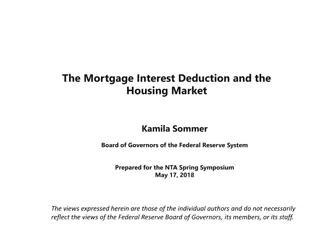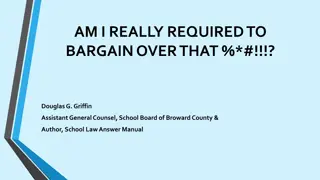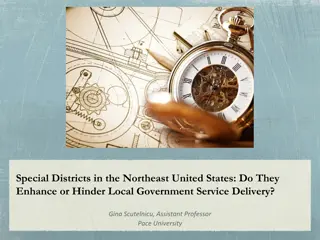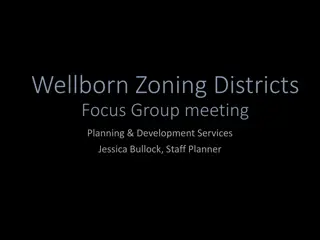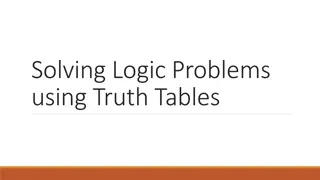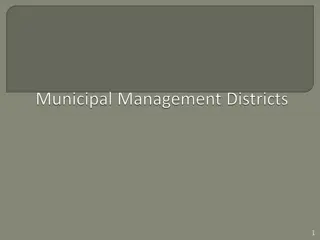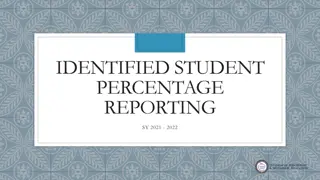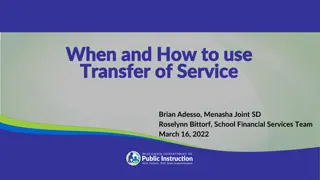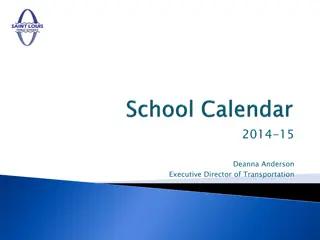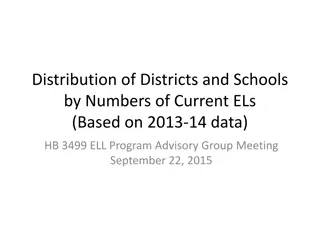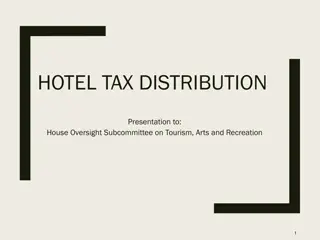Understanding the Truth about Districts and Homeownership Risks
Debunking common misconceptions about districts, this discussion sheds light on the limited obligations and protections for homeowners. It explains how districts provide financial viability and transparency, showcasing the intelligence of homeowners in evaluating their choices.
- Homeownership Risks
- Limited Obligations
- Financial Implications
- Property Taxes
- Real Estate Development
Download Presentation

Please find below an Image/Link to download the presentation.
The content on the website is provided AS IS for your information and personal use only. It may not be sold, licensed, or shared on other websites without obtaining consent from the author. Download presentation by click this link. If you encounter any issues during the download, it is possible that the publisher has removed the file from their server.
E N D
Presentation Transcript
DISTRICT DISCUSSION August 24, 2020
CON: Will cause future bankruptcies. TRUTH: Districts are limited obligations and the only recourse is collection of a mill levy. No lien or encumbrance rights. Mill levies are capped through Legislative action and local government required Service Plan approvals, so the bondholders have no ability to increase mill levies beyond what the HO was initially aware of when making an initial purchase decision in that community (other than a potential Gallagher adjustment and that is by definition revenue neutral.) 2 2
CON: Homeowners don t understand Districts and therefore do not know what they are getting into. TRUTH: Homeowners are intelligent. They compare and contrast development with Districts to developments without. They evaluate financial implications of being in a District, as well as the sales tax implication of being in the City or County. Additionally, the Districts are fully disclosed in the Purchase Contract and in the Title Work. Any quality builder also provides in their disclosure an example of the tax burden on a typical $400k- $500k home. 3 3
CON: Districts put Homeowners at significant risk. TRUTH: Risks of a district are borne exclusively by the bond holders. Often the bond holders initially are the developer prior to substantial build out, i.e. before there is enough tax revenue from assessed value to cover debt service. This initial period is the highest risk to the bond holders and that is why you see initial bond interest rates of 7-9%. There is a premium for that risk and that premium is determined in a spread over AAA credit. In many cases, these bonds are still marketable to institutions and the institutions dictate those rates (cite recent examples). Once development and assessed valuation is established and generating tax revenues, the initial bonds are then refinanced by institutionally rated bonds. You obtain a rating grade from Moody s or S&P and do an underwritten bond offering. Again, the bond market dictates the rate and usually involves a small premium over AAA credit (2.8-3% in recent examples). These blended rates are more efficient and cheaper than traditional financing. 4 4
ADDITIONAL PROTECTIONS The mill levy caps and the necessity of providing a Discharge Date (date upon which the district can no longer tax), as required in COS Special District Model Service Plan, provide further protections for the HO. 5 5
One important aspect not often discussed and rarely understood is that Districts often make a project viable when it otherwise would not be. Indigo Ranch: First phase of Master Plan Revenue: 100 lots @ $85,000 or $8,500,000 in revenue. Cost to Develop: Land: $60,000 per acre or $20,000 per lot with 3 DUA per acre. ($2,000,000) Onsites: grading, erosion control, water, sanitary sewer, gas, electric, onsite detention pond, telephone, curb and gutter, sidewalk, paving, landscaping and fees = $45,000 per lot. ($4,500,000) Arterials Bridge Creek Improvements 6 6
Soft Costs: includes loan interest, property taxes, commissions, subdivision maintenance, marketing and advertising. 7% of lot value or $5,950 per lot. ($595,000) Offsites and Extraordinary Costs: 4 lane Stetson Hills Boulevard, pay a contribution to bridge over Sand Creek, drainage improvements to Sand Creek equate to $30,000 per lot. ($3,000,000) Total Revenue: $8,500,000 ($85,000 per lot) Total Costs: ($10,095,000) (Land, onsites, soft costs and offsites) 7 7
Profit or (Loss): ($1,595,000) The assumption in the previous presentation is that the developer could increase the lot price to $100,950 ($10,095,000 divided by 100 lots) which is not a fair assumption as in this case this lot pricing was already at top of market. Even if the assumption was accurate, an increase in lot price from $85,000 to $100,950, would result in housing costs increasing from $425,000 ($85,000 divided by .20) to $504,750 ($100,950 divided by .20) (lot representing 20% of home value). 8 8
Typical Development Financing: 75% of loan to value or loan to cost, whichever is less. Under typical acquisition and development financing structure the developer could borrow $6,375,000 (75% of $8,500,000 value). Requiring an equity investment of $3,720,000 to incur a loss of $1,595,000. There is no incremental financing available as previous presentation assumes because there is not enough collateral to support the loan. 9 9
With District Financing: Developerobtains $5,321,250 loan from traditional acquisition and development lender (75% of total costs of $7,095,000). Developer issues bonds of $3MM for the Offsite and Extraordinary Costs to pay for those district eligible costs. Summary of financing: Total Costs: $7,095,000 ($10,095,000 minus $3,000,000) Loan Proceeds: $5,321,250 Required Equity: $1,773,750 10 10
In addition to requiring significantly less equity, the District financing structure allows the developer to generate a positive return for the risk undertaken. Revenue: $8,500,000 Costs: $7,095,000 Overhead and Profit: $1,405,000 (17% for overhead and profit) The District structure and the bond proceeds make this a viable development. 11 11


